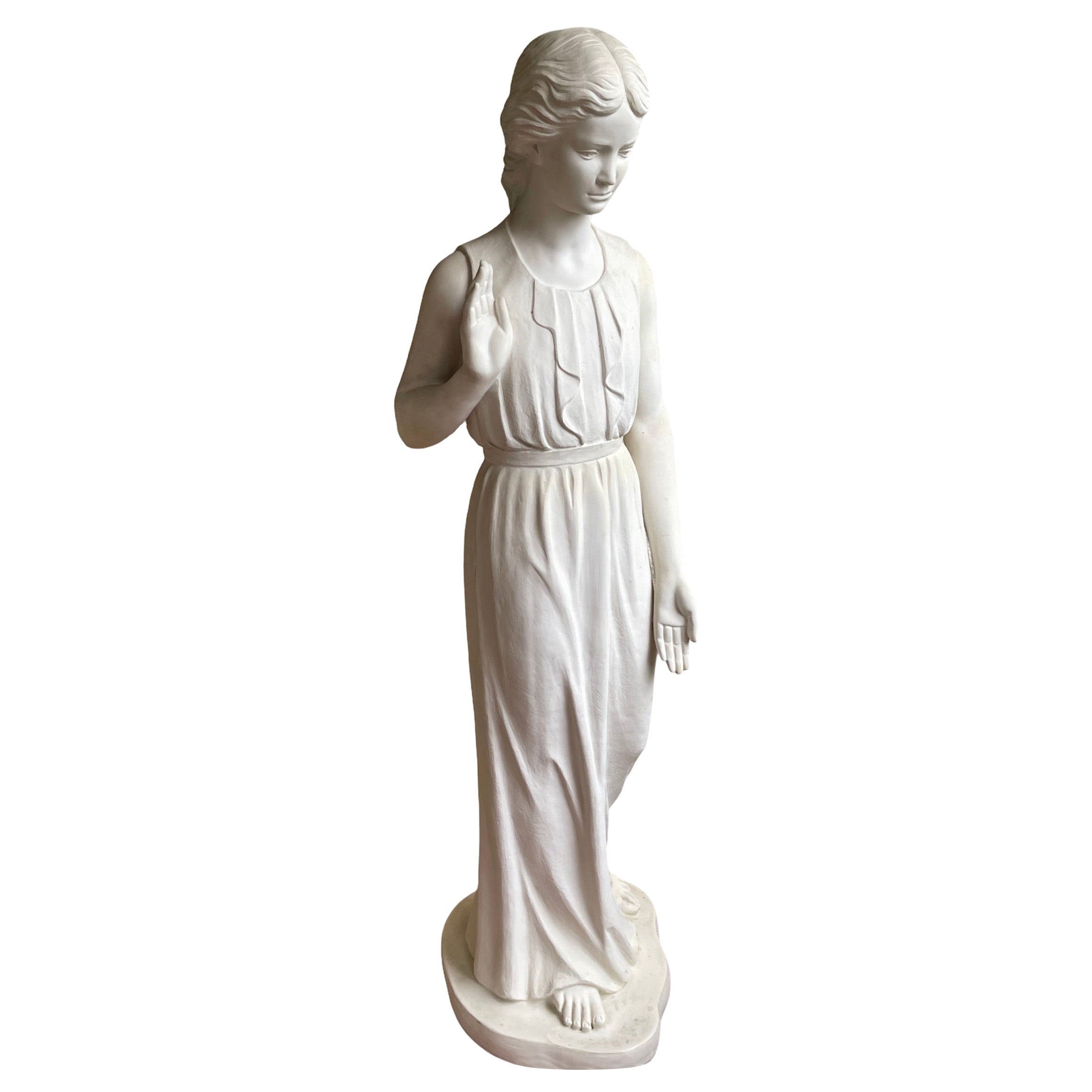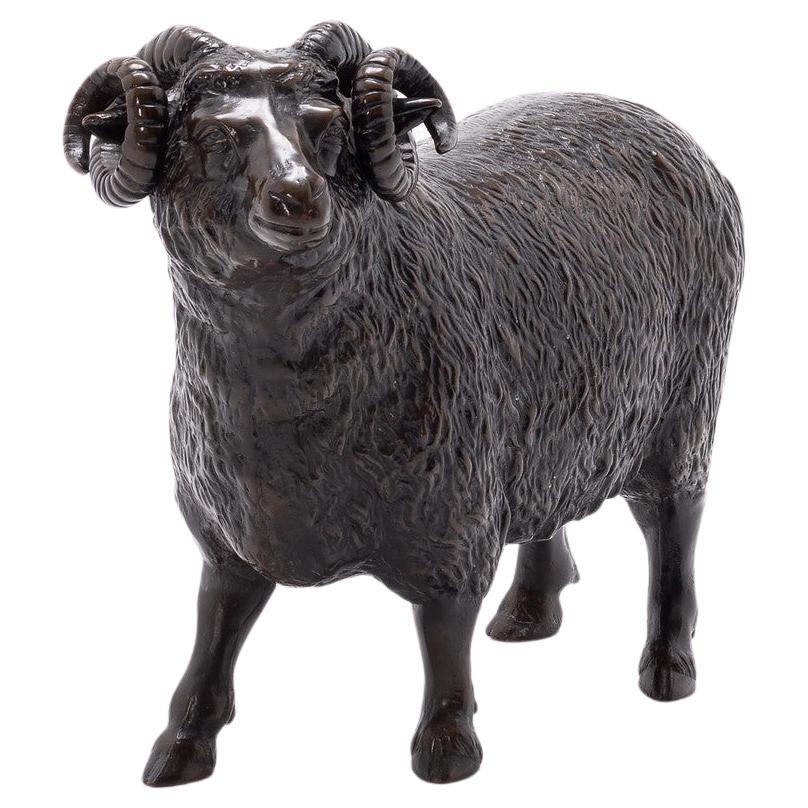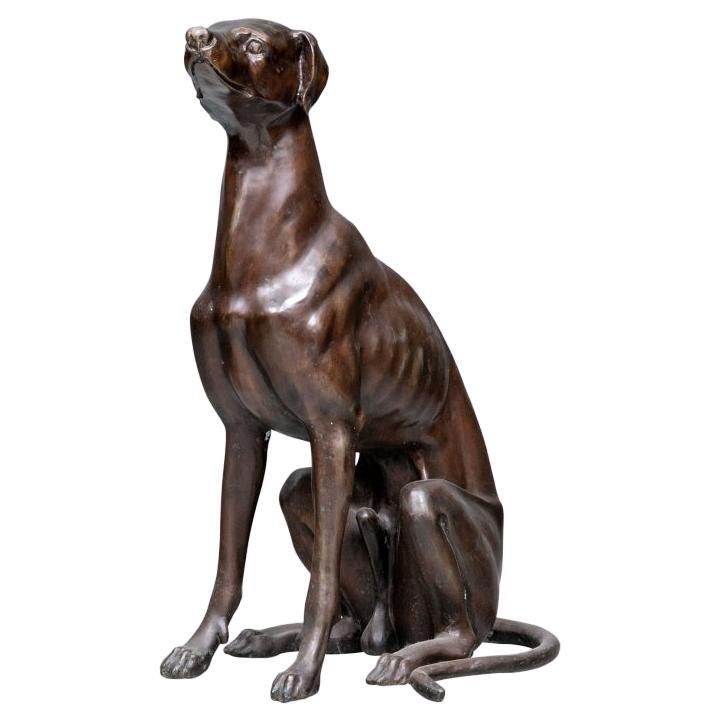Items Similar to Sculpture, statue, garden, wirework, sheep, life-size, folk art, animal, unique
Want more images or videos?
Request additional images or videos from the seller
1 of 18
Sculpture, statue, garden, wirework, sheep, life-size, folk art, animal, unique
About the Item
A Pair of Contemporary, Folk Art, Life-Size, Sheep, Wirework, Garden Sculptures
Hand-sculpted using multiple layers of painted galvanized wire in white and black. Each sculpture is unique. These sheep are very realistic and often mistaken for the real thing, creating humour in the landscape.
“These beautiful, life-size, wire-work animals bring charm and character to any garden ..”
They can be customised and ordered individually
WIREWORK SCULPTURE
Wirework is an ancient art form, probably first practised by the Egyptians around 3000BC. Early examples have been discovered in the burial chambers of important people throughout the ancient world. In 2600BC, wire was used in gold and silver ribbons for entwining in the hair of courtly ladies in the Sumerian city of Ur. The art of wirework spread in various forms from Babylon to Baghdad, Damascus and Constantinople before finally reaching Europe.
Wire was originally made by chiselling thin strips from a sheet of metal. The strips were either twisted and then rolled between two flat surfaces to smooth them or spirally wound around a mandrel. Today wire is made by drawing rods of metal through conically shaped holes in a draw-plate. This system was first used in Persia in the 6th century BC but did not reach Europe until the 10th century AD when wire was first being produced on a commercial scale.
The iron wire trade made chain-mail, and also wool carders, girdles, chains, fish hooks and needles. Up until this time gold and silver wires were made almost exclusively for jewellery but during the Middle Ages embroidery became their principal use. In England, the two trades were governed by different bodies, the Broiders’ Company and the Girdler and Pinmakers’ Company. It was not until the late 17th century that they became distinctive guilds known as the Worshipful Company of Gold and Silver Wireworkers, and the Worshipful Company of Tin Plate Workers, or Wireworkers.
By the mid-16th century, there were at least 6,000 wire drawers in London alone and it was around this time that the first mechanical drawing machines were used in England. The water-driven draw-plate system used in these machines was invented by Rudolf of Nuremberg in the 14th century, but was not introduced to England until 1564. Gold and silver wirework flourished until the time of the French Revolution (1789-99), when fashions changed and the industry went into decline.
Because of the corrodible nature of iron, very few examples of the broad range of objects once made from iron wire have survived to this day, save the items mentioned above and a few toys and traps. By the early 19th century, tinning and black-japanning had become popular ways of protecting the wireworker’s craft. Not only did these treatments prevent rusting, they also helped cement items made from unsoldered wire.
America imported its wire from England and Germany until 1812, when the war with England meant that supplies were cut off. From this point, the Americans started building their own factories for producing wire. By the mid-19th century, the steam engine enabled wire, woven wire and wire fencing to be mass produced. The industry flourished, reaching its peak in Europe and America at the turn of the century, when an impressive range of products was available, from wire whisks and baskets to wire gazebos. The craft of wireworking was applied to every possible household device until the advent of plastic gradually led to its demise.
Alexander Calder (1898-1976) was the first artist who brought wire sculpture art to people's attention was Alexander Calder (, who made a series of wire sculptures in the 1920s after using wire to experiment with jewelry making. The artistic practice of wirework is now enjoying a renaissance in the fine and decorative arts.
- Dimensions:Height: 29.14 in (74 cm)Width: 40.95 in (104 cm)Depth: 14.18 in (36 cm)
- Sold As:Set of 2
- Style:Folk Art (Of the Period)
- Materials and Techniques:
- Place of Origin:
- Period:
- Date of Manufacture:2023
- Production Type:New & Custom(Limited Edition)
- Estimated Production Time:16-17 weeks
- Condition:
- Seller Location:BUNGAY, GB
- Reference Number:1stDibs: LU3867335292552
different breeds, poses and colours
About the Seller
5.0
Vetted Seller
These experienced sellers undergo a comprehensive evaluation by our team of in-house experts.
Established in 1985
1stDibs seller since 2018
84 sales on 1stDibs
Typical response time: 9 hours
- ShippingRetrieving quote...Ships From: BUNGAY, United Kingdom
- Return PolicyA return for this item may be initiated within 7 days of delivery.
More From This SellerView All
- Lion Stone Sculpture Architectural Garden RenaissanceLocated in BUNGAY, SUFFOLKThis sculpture has taken on a different character over time as it has weathered and the detailing has softened. Time has given it a pared down, minimalist quality juxtaposing the R...Category
Antique 16th Century English Renaissance Statues
MaterialsLimestone
- Fox Sculpture Wirework Garden `OrnamentLocated in BUNGAY, SUFFOLKA folk art, life-size, fox, wirework, garden sculpture Hand-sculpted using multiple layers of painted galvanized wire in red, white and black. Each sculpture is unique. This fox is very realistic and often mistaken for the real thing, creating humour in the landscape. “These beautiful, life-size, wire-work animals bring charm and character to any garden ..” This fox can be customised and ordered individually length 91cm., 3ft height 28cm., 11" depth 15cm., 6" WIREWORK SCULPTURE...Category
2010s English Animal Sculptures
MaterialsWire
- Sculpture Lifesize Crane Heron Wrought IronLocated in BUNGAY, SUFFOLKRealistic wrought iron life size, sculpture of a wading crane or large heron Stylish feature in the garden, pond, river, lake or home Measures: height ...Category
20th Century English Animal Sculptures
MaterialsWrought Iron
- Sculpture Sandstone Carved Figurative The ThinkerLocated in BUNGAY, SUFFOLKThe Thinker Mid-Century Modern, sandstone sculpture depicting a seated man, artist unknown This Mid-Century Modern interpretation of The Thinker interprets the pain, release and liberation associated with free-thinking. The man conveys vulnerability, tenderness and acceptance, his body yielding into the support of the chair creating a sense of rest and peace. Provenance: Private Collection acquired from The Hidden Gallery, Scotland Measures: Height 50cm.,20" Length 33cm., 15" Depth 22cm., 81/2" The Thinker - Auguste Rodin (1840 -1917). Cast made by Fonderie Alexis Rudier in 1904. Transfered to the musée Rodin in 1922. When conceived in 1880 in its original size (approx. 70 cm) as the crowning element of The Gates of Hell, seated on the tympanum, The Thinker was entitled The Poet. He represented Dante, author of the Divine Comedy which had inspired The Gates, leaning forward to observe the circles of Hell, while meditating on his work. The Thinker was therefore initially both a being with a tortured body, almost a damned soul, and a free-thinking man, determined to transcend his suffering through poetry. The pose of this figure owes much to Carpeaux’s Ugolino (1861) and to the seated portrait of Lorenzo de’ Medici carved by Michelangelo (1526-31). While remaining in place on the monumental Gates...Category
20th Century English Mid-Century Modern Figurative Sculptures
MaterialsSandstone
- Daschund Ceramic Blue & White Vintage Life Size Sculpture GardenLocated in BUNGAY, SUFFOLKLife-sized, standard Daschund, ceramic sculpture suitable for the home or garden The blue and white stylised flowerhead and trailing acanthus leaf decoration is unusual and fun, evo...Category
Vintage 1950s English Mid-Century Modern Animal Sculptures
MaterialsPorcelain
- Busts Columns Pair of Composite Stone Brutus LaocoonLocated in BUNGAY, SUFFOLKA pair of weathered, composite busts, after the antique, Brutus & Laocoön, raised on integral socle bases, on tall cylindrical columns, 6ft.,3” high The suffering is beautifully con...Category
Early 20th Century Italian Renaissance Revival Figurative Sculptures
MaterialsComposition
You May Also Like
- Antique Terracotta French Renaissance Garden Sculpture StatuesLocated in San Diego, CAWonderful pair of antique painted terracotta garden sculptures or figures with a perfectly aged and weathered patina. Each piece standing just over 2 feet tall.Category
Antique Early 19th Century European Statues
- Large Pair Patinated Life Size Bronze Statues Sculpture of Regal Big Cats LionsLocated in West Hollywood, CALarge pair patinated life size bronze statues sculpture of Regal Big Cats Lions. Exceptional detailed high quality Large pair of Patinated bronze statues of...Category
Mid-20th Century French Statues
MaterialsBronze
- Life Size Bonded or Cold Cast Marble Garden Sculpture of a Young GirlLocated in Guaynabo, PRThis is a bonded marble or cold cast marble garden sculpture of a tall young girl. She is standing up and looking down with her right hand shyly waving and offering her left hand to someone. She is wearing a simple long pleated dress...Category
20th Century Unknown Neoclassical Figurative Sculptures
MaterialsMarble
- 20th Century Bronze Exmoor Horn Sheep, Near Life SizeLocated in Houston, TX20th Century English bronze Exmoor Horn sheep. This breed is a descendant of sheep that had roamed on the moors for several hundred years. Heavy and near ...Category
20th Century English Animal Sculptures
MaterialsBronze
- Early Stone Tiki Garden Statue on BaseBy TikiLocated in Ferndale, MIUnique two pice garden statue. Tiki style form sits in stand. Most likely cast cement.Category
Mid-20th Century American Folk Art Figurative Sculptures
MaterialsCement
- Bronze Sitting Life Size Greyhound SculptureLocated in Bridgeport, CTBronze sitting life size sculpture of a greyhound dog. The dog well cast with soft facial features and ribbed and muscular body, the patina in warm Copper tones. Dimensions: 24" Wi...Category
20th Century Animal Sculptures
MaterialsBronze
Recently Viewed
View AllMore Ways To Browse
Carved Rustic Wood Sculpture
Horned Furniture
Greyhound Italy
Glass Statue Pairs
Terra Cotta Dragon
Antique Indian Wood Horse
Brienz Dog
Decorative Carved Tourmaline Carved
Mache Dog
Large Mid Century Poodle
Pig Sow
De Penne
Baga Serpent
Hanns Peter
Hitching Post Rings
Wire Sculpture Quixote
Cartier Cheetah
Large Wooden Hindu Deity Statues





